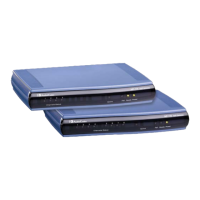Version 7.2 779 Mediant 1000B Gateway & E-SBC
User's Manual 45. Automatic Provisioning
45.1.3 FTP-based Provisioning
The Automatic Update feature provides limited support for FTP/FTPS connectivity. Periodic
polling for updates is not possible since these protocols do not support conditional fetching
(i.e., updating files only if they are changed on the server).
The only difference between FTP-based provisioning and those described in ''HTTP-based
Provisioning'' on page 778 and Provisioning from HTTP Server using DHCP Option 67 on
page 776 is that the protocol in the URL is "ftp" (instead of "http").
45.1.4 Provisioning using AudioCodes EMS
AudioCodes EMS server functions as a core-network provisioning server. The device's
SNMP Manager should be configured with the IP address of the EMS server, using one of
the methods detailed in the previous sections. As soon as a registered device contacts the
EMS server through SNMP, the EMS server handles all required configuration
automatically, upgrading software as needed. This alternative method doesn't require
additional servers at the customer premises, and is NAT-safe.
45.2 HTTP/S-Based Provisioning using the Automatic
Update Feature
The Automatic Update feature can be used for automatic provisioning of the device through
HTTP/S. Automatic provisioning is useful for large-scale deployment of devices. In some
cases, the devices are shipped to the end customer directly from the manufacturer. In other
cases, they may pass through a staging warehouse. Configuration may occur at the
staging warehouse or at the end-customer premises.
The device may be preconfigured during the manufacturing process (commonly known as
private labeling). Typically, a two-stage configuration process is implemented whereby
initial configuration includes only basic configuration, while the final configuration is done
only when the device is deployed in the live network.
Warning: If you use the IniFileURL parameter for the Automatic Update feature, do
not use the Web interface to configure the device. If you do configure the device
through the Web interface and save (burn) the new settings to the device's flash
memory, the IniFileURL parameter is automatically set to 0 and Automatic Updates is
consequently disabled. To enable Automatic Updates again, you need to re-load the
ini file (using the Web interface or BootP) with the correct IniFileURL settings. As a
safeguard to an unintended save-to-flash when resetting the device, if the device is
configured for Automatic Updates, the 'Burn To FLASH' field under the Reset
Configuration group in the Web interface's Maintenance Actions page is automatically
set to No by default.
Note:
• For a description of all the Automatic Update parameters, see ''Automatic Update
Parameters'' on page 938 or refer to the CLI Reference Guide.
• For additional security, use HTTPS or FTPS. The device supports HTTPS (RFC
2818) and FTPS using the AUTH TLS method <draft-murray-auth-ftp-ssl-16>.

